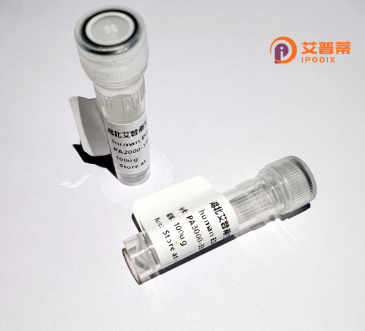
| 纯度 | >90%SDS-PAGE. |
| 种属 | Human |
| 靶点 | HCG3 |
| Uniprot No | Q8WWF6 |
| 内毒素 | < 0.01EU/μg |
| 表达宿主 | E.coli |
| 表达区间 | 1-145aa |
| 氨基酸序列 | MVDYYEVLDV PRQASSEAIK KAYRKLALKW HPDKNPENKE EAERRFKQVA EAYEVLSDAK KRDIYDRYGE AGAEGGCTGG RPFEDPFEYV FSFRDPADVF REFFGGQDPF SFDLLGNPLE NILGGSEELL GKQKQSVCTP FLCLQ |
| 分子量 | 16.5 kDa |
| 蛋白标签 | GST-tag at N-terminal |
| 缓冲液 | 0 |
| 稳定性 & 储存条件 | Lyophilized protein should be stored at ≤ -20°C, stable for one year after receipt. Reconstituted protein solution can be stored at 2-8°C for 2-7 days. Aliquots of reconstituted samples are stable at ≤ -20°C for 3 months. |
| 复溶 | Always centrifuge tubes before opening.Do not mix by vortex or pipetting. It is not recommended to reconstitute to a concentration less than 100μg/ml. Dissolve the lyophilized protein in distilled water. Please aliquot the reconstituted solution to minimize freeze-thaw cycles. |
以下是关于重组人绒毛膜促性腺激素(hCG,可能为用户所指的HCG3)的参考文献示例,包括文献名称、作者及摘要概括:
1. **文献名称**:*Production of recombinant human chorionic gonadotropin in Chinese hamster ovary cells*
**作者**:Birken S, et al.
**摘要**:描述了在CHO细胞中表达重组hCG的方法,验证其生物活性与天然hCG一致,并分析了糖基化结构,为大规模生产提供了技术基础。
2. **文献名称**:*Structural and functional characterization of recombinant human chorionic gonadotropin using mass spectrometry*
**作者**:Valmu L, et al.
**摘要**:通过质谱技术系统分析重组hCG的糖链组成和蛋白结构,证明其翻译后修饰与天然激素高度相似,支持其在临床治疗中的应用。
3. **文献名称**:*Comparative efficacy of recombinant versus urinary hCG for ovulation triggering in IVF/ICSI cycles*
**作者**:Al-Inany H, et al.
**摘要**:对比研究显示,重组hCG在辅助生殖中触发排卵的效果与尿源性hCG相当,且免疫原性更低,安全性更优。
4. **文献名称**:*Optimization of recombinant hCG expression in HEK293 cells for therapeutic use*
**作者**:Gervais A, et al.
**摘要**:研究通过改进HEK293细胞培养条件及载体设计,显著提高了重组hCG的产量和稳定性,为工业化生产提供了新策略。
**备注**:标准术语中“HCG3”可能为用户笔误,上述文献均围绕重组hCG展开。若用户特指某一变体,建议进一步确认命名或补充关键词重新检索。
Recombinant human chorionic gonadotropin (hCG) is a glycoprotein hormone produced through genetic engineering, structurally and functionally mimicking the native hCG secreted by placental syncytiotrophoblasts during pregnancy. Native hCG consists of two subunits: a common α-subunit shared with other glycoprotein hormones (like LH, FSH, TSH) and a unique β-subunit that confers receptor specificity. Recombinant hCG replicates this heterodimeric structure, enabling its binding to luteinizing hormone/hCG receptors in the ovaries and testes.
Developed to overcome limitations of urinary-derived hCG (u-hCG), recombinant hCG offers higher purity, batch consistency, and reduced risk of allergic reactions. It is widely used in assisted reproductive technologies (ART) to trigger final oocyte maturation and ovulation induction in controlled ovarian stimulation protocols. Additionally, it supports luteal phase function and enhances testosterone production in male hypogonadism.
The production involves transfecting mammalian cells (e.g., Chinese hamster ovary cells) with genes encoding both subunits, followed by secretion, purification, and formulation. Its clinical efficacy and safety are well-established, with applications expanding to include management of cryptorchidism and oligospermia. As a biopharmaceutical, recombinant hCG exemplifies advancements in protein engineering, bridging reproductive endocrinology and therapeutic innovation.
×